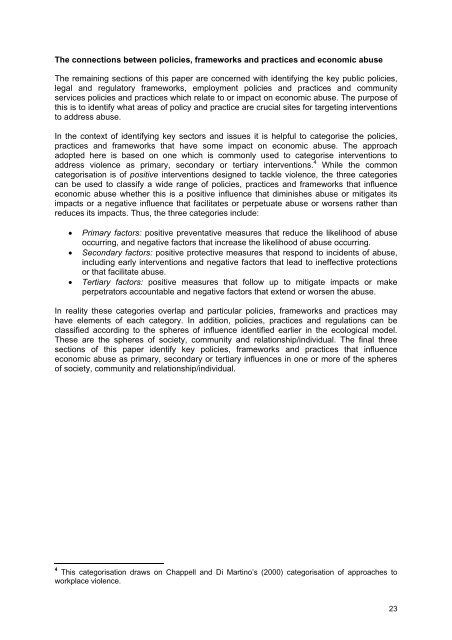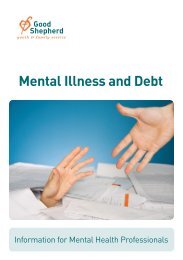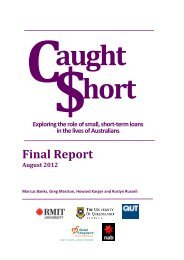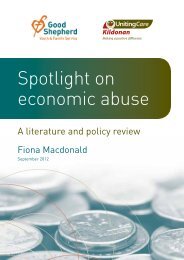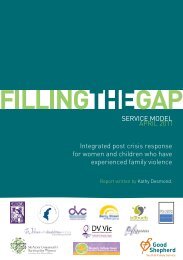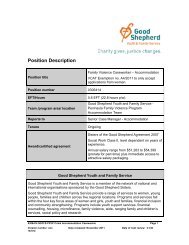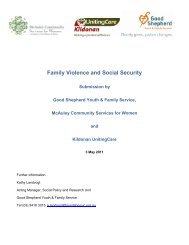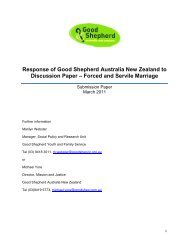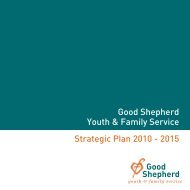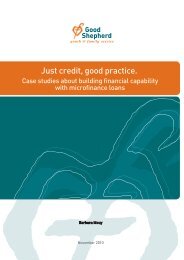Spotlight on economic abuse - Good Shepherd Youth & Family ...
Spotlight on economic abuse - Good Shepherd Youth & Family ...
Spotlight on economic abuse - Good Shepherd Youth & Family ...
Create successful ePaper yourself
Turn your PDF publications into a flip-book with our unique Google optimized e-Paper software.
The c<strong>on</strong>necti<strong>on</strong>s between policies, frameworks and practices and ec<strong>on</strong>omic <strong>abuse</strong><br />
The remaining secti<strong>on</strong>s of this paper are c<strong>on</strong>cerned with identifying the key public policies,<br />
legal and regulatory frameworks, employment policies and practices and community<br />
services policies and practices which relate to or impact <strong>on</strong> ec<strong>on</strong>omic <strong>abuse</strong>. The purpose of<br />
this is to identify what areas of policy and practice are crucial sites for targeting interventi<strong>on</strong>s<br />
to address <strong>abuse</strong>.<br />
In the c<strong>on</strong>text of identifying key sectors and issues it is helpful to categorise the policies,<br />
practices and frameworks that have some impact <strong>on</strong> ec<strong>on</strong>omic <strong>abuse</strong>. The approach<br />
adopted here is based <strong>on</strong> <strong>on</strong>e which is comm<strong>on</strong>ly used to categorise interventi<strong>on</strong>s to<br />
address violence as primary, sec<strong>on</strong>dary or tertiary interventi<strong>on</strong>s. 4 While the comm<strong>on</strong><br />
categorisati<strong>on</strong> is of positive interventi<strong>on</strong>s designed to tackle violence, the three categories<br />
can be used to classify a wide range of policies, practices and frameworks that influence<br />
ec<strong>on</strong>omic <strong>abuse</strong> whether this is a positive influence that diminishes <strong>abuse</strong> or mitigates its<br />
impacts or a negative influence that facilitates or perpetuate <strong>abuse</strong> or worsens rather than<br />
reduces its impacts. Thus, the three categories include:<br />
<br />
<br />
<br />
Primary factors: positive preventative measures that reduce the likelihood of <strong>abuse</strong><br />
occurring, and negative factors that increase the likelihood of <strong>abuse</strong> occurring.<br />
Sec<strong>on</strong>dary factors: positive protective measures that resp<strong>on</strong>d to incidents of <strong>abuse</strong>,<br />
including early interventi<strong>on</strong>s and negative factors that lead to ineffective protecti<strong>on</strong>s<br />
or that facilitate <strong>abuse</strong>.<br />
Tertiary factors: positive measures that follow up to mitigate impacts or make<br />
perpetrators accountable and negative factors that extend or worsen the <strong>abuse</strong>.<br />
In reality these categories overlap and particular policies, frameworks and practices may<br />
have elements of each category. In additi<strong>on</strong>, policies, practices and regulati<strong>on</strong>s can be<br />
classified according to the spheres of influence identified earlier in the ecological model.<br />
These are the spheres of society, community and relati<strong>on</strong>ship/individual. The final three<br />
secti<strong>on</strong>s of this paper identify key policies, frameworks and practices that influence<br />
ec<strong>on</strong>omic <strong>abuse</strong> as primary, sec<strong>on</strong>dary or tertiary influences in <strong>on</strong>e or more of the spheres<br />
of society, community and relati<strong>on</strong>ship/individual.<br />
4 This categorisati<strong>on</strong> draws <strong>on</strong> Chappell and Di Martino’s (2000) categorisati<strong>on</strong> of approaches to<br />
workplace violence.<br />
23


